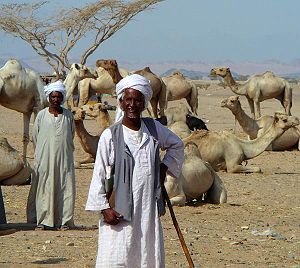Beja people
 Beja Bedouins | |
| Regions with significant populations | |
|---|---|
| Sudan, Egypt, Eritrea | |
| Languages | |
| Beja, Tigrinya, Arabic | |
| Religion | |
| Sunni Islam | |
| Related ethnic groups | |
| Afar, Amhara, Oromo, Saho, Somalis, Tigray, Tigre |
The Beja (Template:Lang-ar) are an ethnic group dwelling in parts of North Africa and the Horn of Africa.
Geography
The Beja are found mostly in Sudan, but also in parts of Eritrea, and Egypt. They formerly were classified as belonging to the Hamitic race (a classification now generally regarded as scientifically[1] incorrect).
Most of them live in the Sudanese states of Red Sea around Port Sudan, River Nile, Al Qadarif and Kassala, as well as in Northern Red Sea, Gash-Barka, and Anseba Regions in Eritrea, and southeastern Egypt. There are smaller populations of other Beja ethnic groups in Egypt's Western Desert as well as Yemen and Puntland. Some Beja groups are nomadic. Kharga Oasis in Egypt is home to a large number of Qamhat Bisharin displaced by the Aswan High Dam.
Names
In ancient Egyptian times, the Beja were known as Ta-Seti[citation needed] and were renowned for their skill as archers in the Egyptian army.
The Beja have also been named "Blemmyes" in Roman times[citation needed], "Buga"s in Aksumite inscriptions in Ge'ez[citation needed], and "Fuzzy Wuzzy" by Rudyard Kipling. Kipling was specifically referring to the Hadendowa, who fought the British, supporting the "Mahdi," a Sudanese leader of a rebellion against the Turkish rule administered by the British. [2]
Language
The Beja speak Beja or To Bedawie, an Afro-Asiatic language (usually classified as Cushitic, but sometimes seen as an independent branch), but a significant number also speak Tigre or Arabic, also both Afro-Asiatic languages, but of the Semitic branch.
Subdivisions
The Bejas contain smaller tribes, such as the Bisharin, Hedareb, Hadendowa (or Hadendoa), the Amarar (or Amar'ar), Beni-Amer, Hallenga and Hamran, some of them partly mixed with Bedouins.[citation needed] The European colonial masters and the explorers became fascinated with the Bejas which they often described in eulogistic terms.
The Bejas attach a high importance to their hair. Their prominent crown of fuzzy hair (called tiffa in their language) has characterized the Beja for centuries. Bejas believe that they are the descendants of a Lioness deity and her human consort. Egyptian Bejawi tribes believe that they are descendants of High Priestesses of Amen and their Maahes Caste Warrior Chiefs. Priest-Kings Pinudjem, Psusennese and Masaharta and their soldiers are believed to be the ancestors of Egypt's Western Desert Bejawi. Omdas Sheikh Qamhat Khawr al`allaqi was last remnant of one of Egypt's oldest surviving lineages. His death in 1936 was widely considered the death knell for the Qamhat Bisharin. Egyptologist Emile Brugsch traced Qamhat Khawr kiji tribal clans through female lines to the 20th Dynasty Wehem Mesut. The Bisharin Qamhat Khawr kiji claim their ancestress was the mother of an even earlier dynasty.
Religion
Ta-Seti Neferet, the mother of Egyptian Pharaoh Amenhemet I, was from Bejawi tribal lands, known as Ta-Seti. Beja worshiped Isis at Philae until the 6th century. After the temple was closed down officially in the 6th century A.D. by the Byzantine emperor Justinian, Beja converted to Christianity in the 6th century under the influence of the three Nubian Christian Kingdoms that flourished along the Nile for 600 years: Nobatia, Makuria, and Alodia, as well as the Christian Kingdom of Aksum, under whose rule most lived from the 3rd to 8th centuries. Around the decline of the Aksumite kingdom, the Bejas founded five kingdoms in what is now northern Eritrea and east-northeastern Sudan. In the 13th century, the Beja accepted Islam as the Bedouin tribes spread into Sudan and swamped the Nubian kingdoms. As of 2007, the majority of Beja are believed to be Muslim. Nevertheless, many Coptic Upper Egyptians of Saiddi and Beja stock are still Christians. There are many Sufi Bejas especially in Egypt's Western Desert.
See also
References
- ^ Hiernaux J (1975) The People of Africa. New York: Charles Scribner's Sons, pp. 147
- ^ http://orvillejenkins.com/profiles/beja.html
The National Movement for Eastern Sudan
External links
- The Beja Congress
- The Beja People of Sudan, Eritrea and Egypt
- Fighting erupts in Eastern Sudan
- The National Movement for Eastern Sudan - NMES
Bibliography
The Bejas figure prominently in Hans Hass's book Under the Red Sea which contains numerous descriptions of this populace as witnessed by the author on the ground in the 1950s Hans Hass - Under the Red Sea With Spear and Camera 1953. Published by Rand McNally & Company Translated from the German by James Cleugh.
